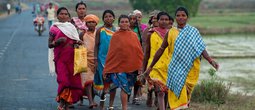21st Century Slavery & Human Trafficking
July 30, 2018
![child-labor1[1].jpg](https://blog.gfa.ca/media/images/child-labor11.max-920x750.jpg)
Higher than the entire population of Canada is today’s estimated global slave population. Slavery may long have been officially outlawed but numerically, there are more slaves today than at any time in history!
Since 2011, almost 90 million people have experienced some form of modern slavery for periods of time ranging from a few days to several years. Total profits from this trade in slave labour are dwarfed only by sales of illegal drugs and illicit arms.
“”In 1850, an average slave in the American South cost the equivalent of $40,000 in today’s money. Today a slave costs about $90 on average worldwide.
- Free the Slaves
So concerning is the issue that it is spotlighted by not one but two of the UN’s annual international awareness days – June 12, World Day Against Child Labour, and July 30, World Day Against Trafficking in Persons.
Of the 25 million people ensnared in forced labour in 2016, five million were involved in sexual exploitation. Sex trafficking doesn’t only generate more headlines than other forms, though; it also generates a lot more money.
A woman or underage girl forced into prostitution makes $100,000+ a year of profit for those who control her, six times the average profit of other forced workers. Human Rights First says that studies have shown that sexual exploitation can yield a return on investment ranging from 100 percent to 1,000 percent, while an enslaved labourer in less profitable markets—such as agricultural work—can generate something over 50 percent profit.
Such numbers underscore how human trafficking is really big business. As with so many of the world’s major problems, the causes are complex. Politics and prejudice, commerce and corruption, disasters and discrimination are all part of the roots of this diseased tree.
“”This is a human condition…not thrust upon us by nature. This is the choice of man, so the choice of man can stop it.
- Anti-slavery campaigner, Andrew Forrest
Cashing In on Chaos
Like a virus, human trafficking continues to mutate. Women have long been considered to be the main victims, and that is certainly true in the sex trade, where they comprise 99 percent of those used and abused.
As the numbers of those trafficked for forced labour have increased over the last decade, so has the number of trafficked men, who can be subject to particularly brutal treatment. Survivors of forced labour in the Thai fishing industry have told of being made to take amphetamines to enable them to work long hours and of being dragged through the water with a rope around their neck for complaining. Those who tried to escape were executed and their bodies thrown overboard.
![collage-thai-fishing[1].jpg](https://blog.gfa.ca/media/images/collage-thai-fishing1.width-800.jpg)
Trafficking has also grown and morphed in the wake of the refugee crises in Europe and parts of Africa and Asia.
“Refugees and unaccompanied children are some of the most vulnerable targets of labour and sex traffickers,” warns the UN. Mass movements of people in times of great upheaval leave many vulnerable to being taken advantage of and provide opportunities for traffickers to move even more freely.
“In the chaos of conflict and violence, a perfect storm of lawlessness, slavery, and environmental destruction can occur—driving the vulnerable into slave-based work that feeds into global supply chains and the things we buy and use in our daily lives,” say Global Slavery Index publishers.
Clearly, governments have a major role to play in ending slavery, and leaders are taking steps in places like India, where tougher anti-trafficking laws have been pursued. Of 161 countries profiled in the Global Slavery Index, 150 governments provide some kind of services for victims, 124 have criminalized human trafficking, and 96 have national action plans to do something about it.
GFA’s Work Among Victims of Slavery
Among the many unnamed people helping are scores of GFA-supported workers. They care for women and girls ensnared in the red-light districts of major cities, and they run Bridge of Hope centres that provide schooling and medical care, aiming to help children escape forced labour and provide them with a better future. Through GFA’s ministry, children and their families don’t only receive practical help; they also hear about God’s love for them.
“”It’s amazing how the love of Christ brings hope to the poorest of society and fills the hearts of these children with joy.
- Dr. K.P. Yohannan, Founder and Director of GFA World
While slavery is a global problem that’s difficult to eradicate, there is still hope. As Forrest said, “This is the choice of man, so the choice of man can stop it.”
Learn about GFA’s Red-Light Ministry
Read Full Article by Palmer Holt of InChrist Communications
Sources
https://www.un.org/en/events/childlabourday/
https://www.un.org/en/events/humantrafficking/
https://www.humanrightsfirst.org/resource/human-trafficking-numbers




